初中英语九年级上册课件Unit 5 What are the shirts made of? Section B 2 (2a-2e)(共39张PPT)
文档属性
| 名称 | 初中英语九年级上册课件Unit 5 What are the shirts made of? Section B 2 (2a-2e)(共39张PPT) | 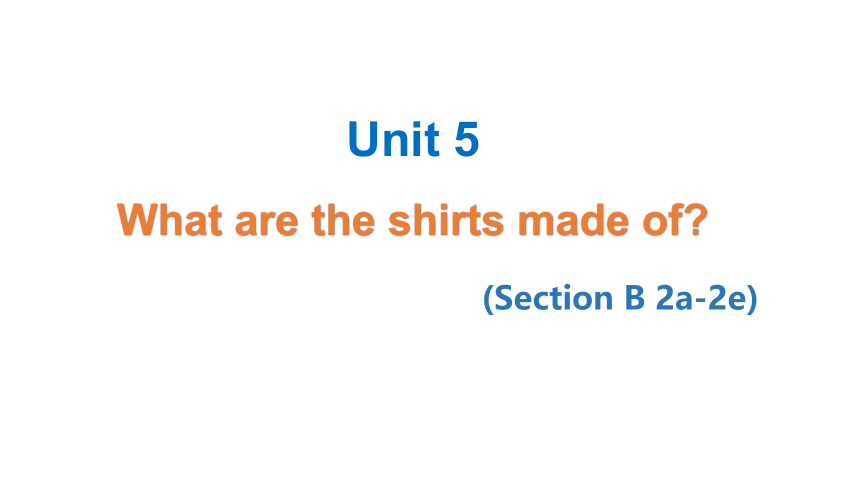 | |
| 格式 | pptx | ||
| 文件大小 | 1.5MB | ||
| 资源类型 | 教案 | ||
| 版本资源 | 人教新目标(Go for it)版 | ||
| 科目 | 英语 | ||
| 更新时间 | 2023-09-14 19:08:52 | ||
图片预览

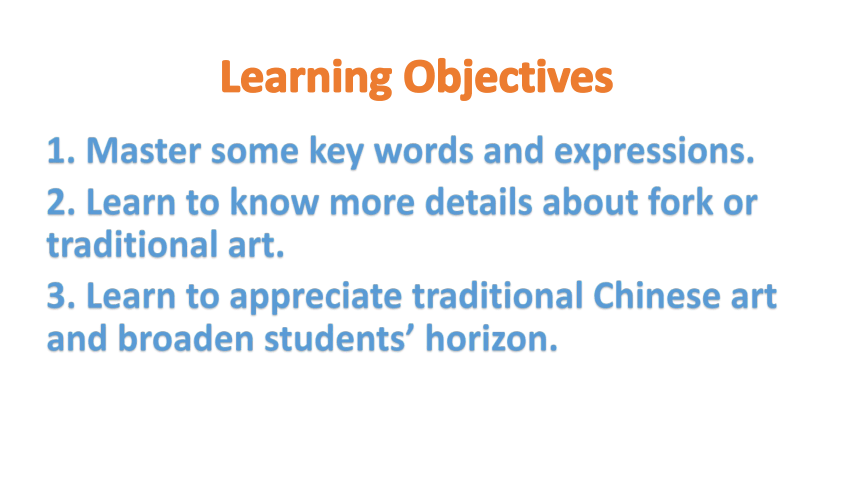
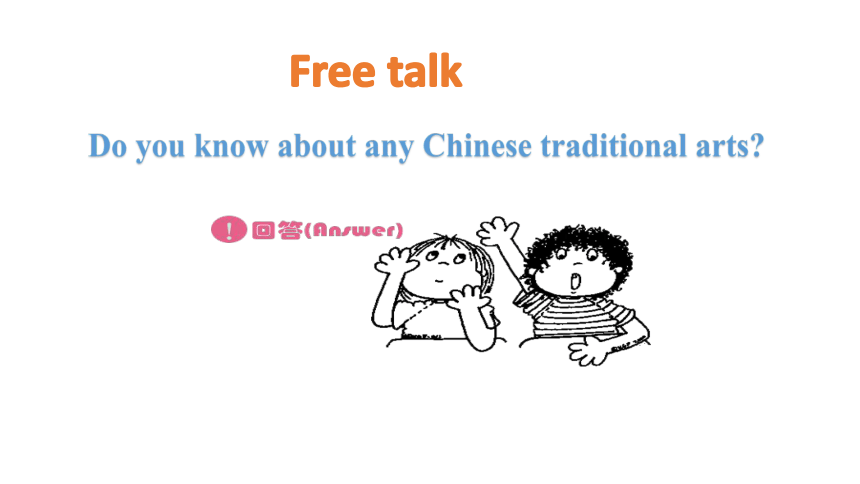
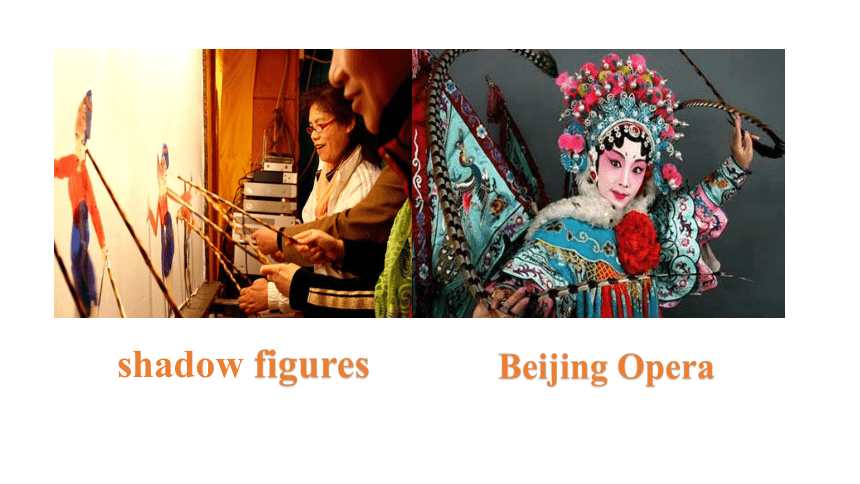
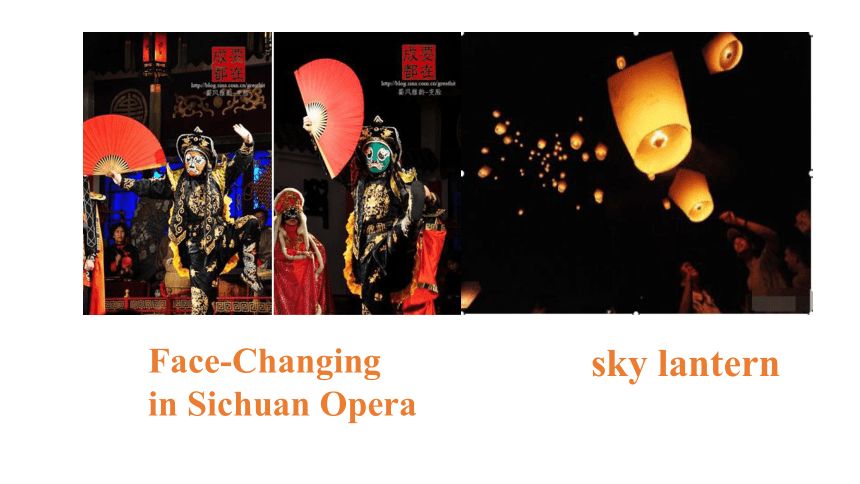
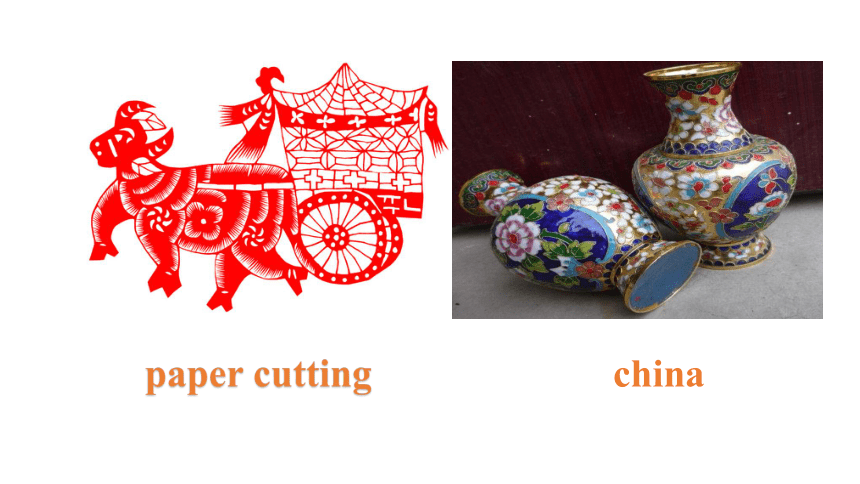
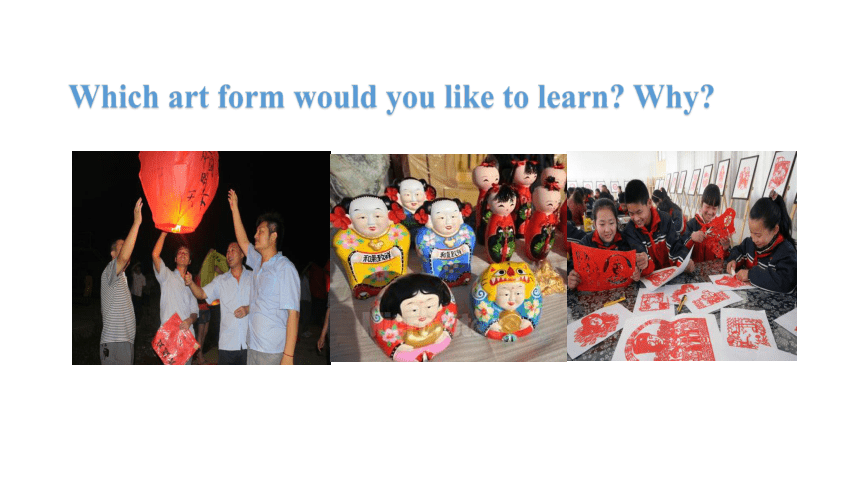
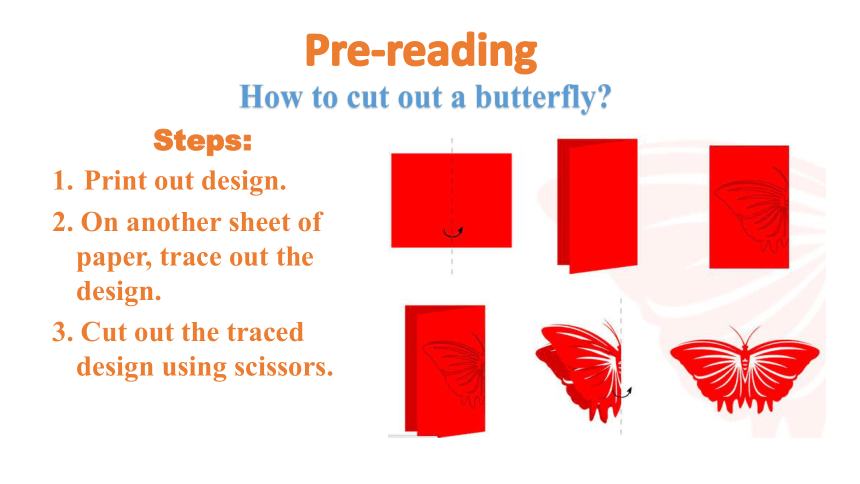
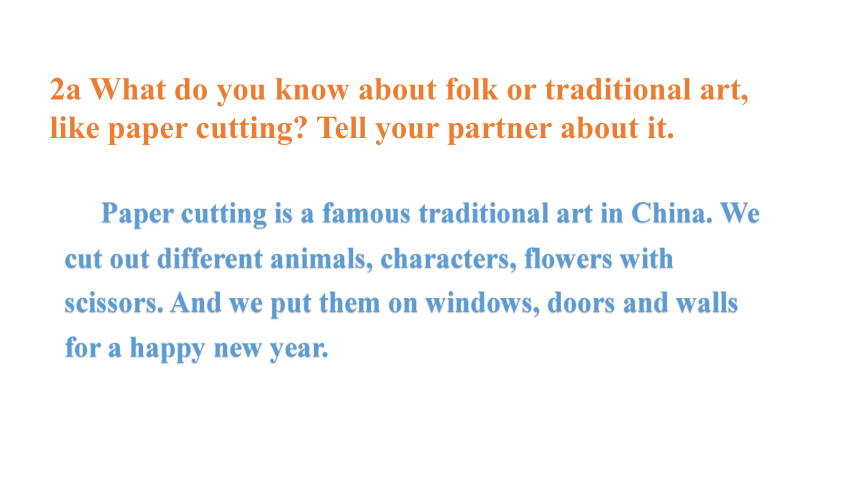
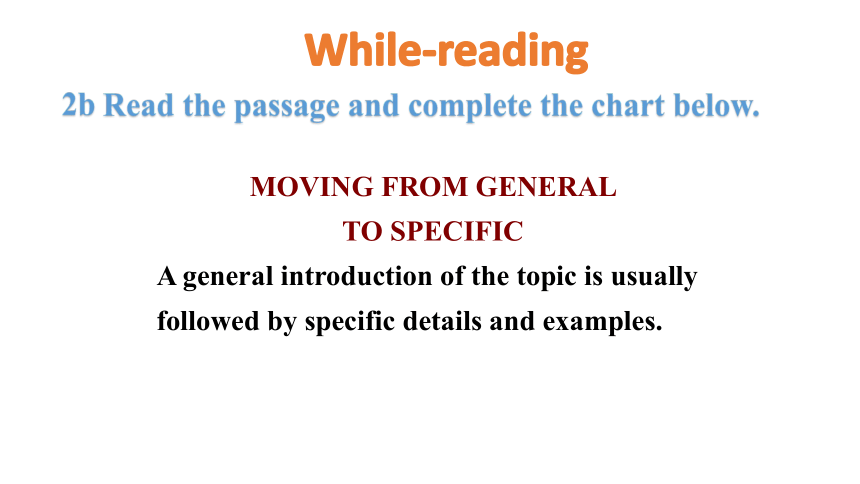
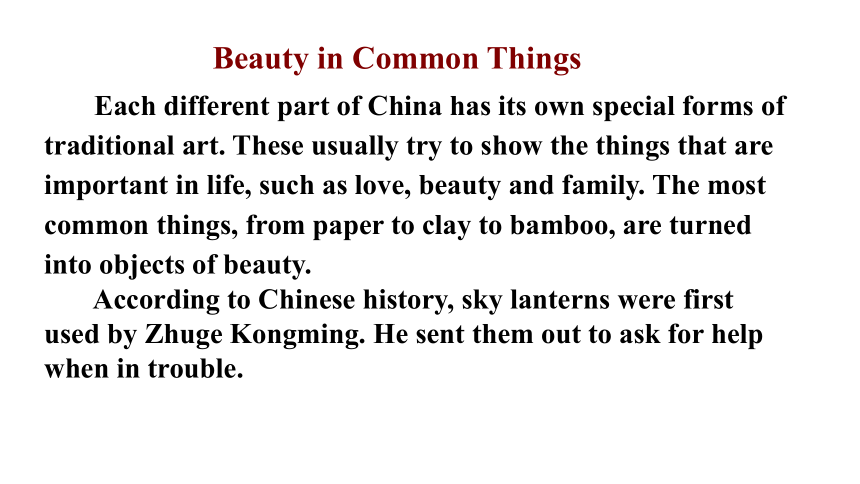
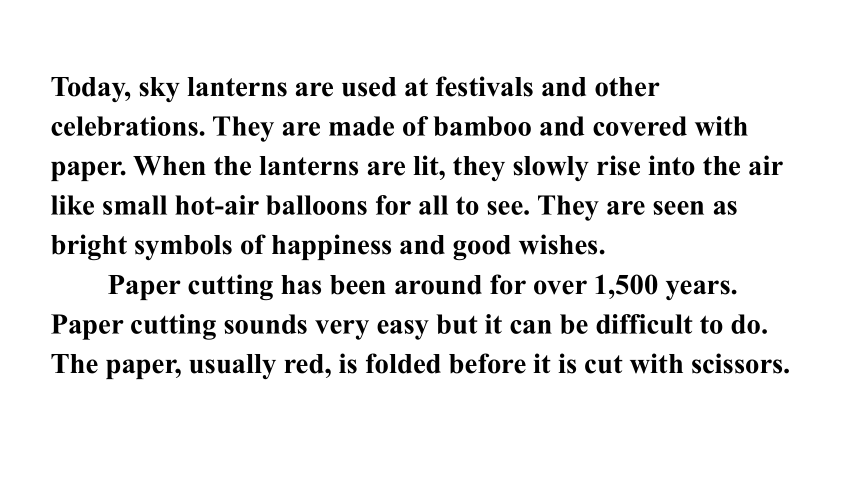
文档简介
(共39张PPT)
Unit 5
What are the shirts made of
(Section B 2a-2e)
1. Master some key words and expressions.
2. Learn to know more details about fork or traditional art.
3. Learn to appreciate traditional Chinese art and broaden students’ horizon.
Learning Objectives
Do you know about any Chinese traditional arts
Free talk
shadow figures
Beijing Opera
sky lantern
Face-Changing
in Sichuan Opera
paper cutting
china
Which art form would you like to learn Why
Steps:
Print out design.
2. On another sheet of paper, trace out the design.
3. Cut out the traced design using scissors.
How to cut out a butterfly
Pre-reading
2a What do you know about folk or traditional art, like paper cutting Tell your partner about it.
Paper cutting is a famous traditional art in China. We cut out different animals, characters, flowers with scissors. And we put them on windows, doors and walls for a happy new year.
While-reading
2b Read the passage and complete the chart below.
MOVING FROM GENERAL
TO SPECIFIC
A general introduction of the topic is usually followed by specific details and examples.
Beauty in Common Things
Each different part of China has its own special forms of traditional art. These usually try to show the things that are important in life, such as love, beauty and family. The most common things, from paper to clay to bamboo, are turned into objects of beauty.
According to Chinese history, sky lanterns were first used by Zhuge Kongming. He sent them out to ask for help when in trouble.
Today, sky lanterns are used at festivals and other celebrations. They are made of bamboo and covered with paper. When the lanterns are lit, they slowly rise into the air like small hot-air balloons for all to see. They are seen as bright symbols of happiness and good wishes.
Paper cutting has been around for over 1,500 years. Paper cutting sounds very easy but it can be difficult to do. The paper, usually red, is folded before it is cut with scissors.
The most common pictures are flowers, animals, and things about Chinese history. During the spring festival, they are put on windows, doors and walls as symbols of wishes for good luck and a happy new year.
Chinese clay art is famous because the clay pieces are so small but they look very real. The pieces are usually cute children or lively characters from a Chinese fairy tale or
historical story. The pieces are carefully shaped by hand from a very special kind of
clay and then allowed to air-dry. After drying, they are fired at a very high heat. They are then polished and painted. It takes several weeks to complete everything. These small pieces of clay art show the love that all Chinese people have for life and beauty.
Traditional art form Materials used
1.
2.
3.
sky lanterns
bamboo, paper
paper cutting
paper
Chinese clay art
clay
While-reading
2c Read the passage again and answer the questions.
1. What do traditional Chinese art forms try to show
They try to show the things that are important in life, such as love, beauty and family.
2. What were sky lanterns used for before and what are they used for now
They were used for asking for help before, and they are used for making wishes at festivals and other celebrations now.
Post-reading
3. What kinds of pictures are usually found on paper cuttings
On paper cuttings, the most common pictures are flowers, animals, and things about Chinese history.
How do people use paper cuttings during the Spring Festival
People put paper cuttings on windows, doors and walls as symbols of wishes for good luck and a happy new year.
5. What are the steps for making clay art pieces
First, they are carefully shaped by hand from a very special kind of clay and then allowed to air-dry. After that, they are fired at a very high heat and then polished and painted.
6. Which art form do you think is the most interesting Why
Chinese clay art. Because they are so small but they look very real.
Language points
Each different part of China has its own special forms of traditional art.
中国每个不同的地区都有各自独特的传统艺术形式。
form 此处用作可数名词,意为 “形式;类型”。
These are two different forms of the same thing.
这是同一事物的两种不同形式。
(2) form 作名词,还可以表示“表格(纸)”。
Please fill in this form, giving your name, address and business.
请填一下这张表, 写上你的姓名、地址、和职业。
(3) form还可以作动词,意为“构成;组成”。
We formed a study group.
我们组成了一个学习小组。
2. The most common things, from paper to clay to bamboo, are turned into objects of beauty. 最普通的东西,从纸到黏土再到竹子,都变成了美丽的物品。
turn ... into …是动词短语,意为“把……变成……”。
The farmers are turning wasteland into rice fields.
农民们正把荒地变成稻田。
turn on 打开
turn off 关闭
turn up 调大(音量)
turn down 调小(音量)
turn against 背叛
turn in 上交
turn over 翻转
3. He sent them out to ask for help when in trouble.
当遇到麻烦的时候,他就放孔明灯以寻求帮助。
(1) send out意为“发出;放出;发送”,是“动词+副词”短语,代词作宾语时,要放在两者之间。但如果名词作宾语,可以放在短语后面,也可放在短语中间。
The sun sends out light and heat.
太阳发出光和热。
(2) when in trouble是状语从句的省略句,当主句主语和从句主语相同且从句中有be动词时,可以把从句中的主语以及be动词省略。
I saw him while (I was) waiting for the bus.
等公共汽车的时候我看见他了。
He fell asleep when (he was) on duty.
他值班的时候睡着了。
4. They are made of bamboo and covered with paper.
它们由竹子制成,外面被糊上纸。
be covered with 意为“被……覆盖”。
The whole land is covered with white snow.
整个大地都被白雪盖住了。
be covered by 也表示“被……覆盖”是被动语态结构,
be covered with是系表结构,译为“到处都是”。
The field is covered by water. 地被水淹了。
The field is covered with water.
5. When the lanterns are lit, they slowly rise into the air like small hot-air balloons for all to see.
孔明灯被点燃后会慢慢上升到空中,像小型的热气球,能被所有人看见。
rise into意为“上升到;升入”。
Chang’e-3 rose into space within seconds.
短短几秒钟之内,“嫦娥三号”升入太空。
6. They are seen as bright symbols of happiness and good wishes.
它们被看作是幸福和美好祝福的光明的象征。
as介词,意为“作为;当作”。
He works in the school as a teacher of math.
他在学校里担任数学教师。
(1) as 意为“因为;由于”引导原因状语从句。
You must hurry up as there is little time left.
你必须快点,因为剩下的时间不多了。
(2) as 意为“像;按照”引导方式状语从句。
You must do everything as I asked you to.
你必须按我要求的那样做每件事。
(3) as 意为“当……的时候;一边……一边……”引导时间状语从句。
She sings as she walks. 她边走边唱歌。
as 的用法
7. The paper, usually red, is folded before it is cut with scissors.
通常是红色的纸,在用剪刀裁剪之前要先折叠。
scissors意为“剪刀”,是名词复数形式,常用表达: a pair of scissors 一把剪刀。“a pair of + 复数名词 ” 作主语时,谓语动词与pair形式一致。
A pair of scissors costs a little, in fact.
一把剪刀实际上花不了几个钱。
8. The pieces are usually cute children or lively characters from a Chinese fairy tale or historical story.
这些工艺品通常是可爱的孩子,或者是源自中国童话故事或者历史故事中的活泼的人物形象。
lively意为“生气勃勃的;活泼的;(色彩)鲜艳的”。
She may be 80, but she’s still lively.
她也许有八十岁了,但仍精力充沛。
lively “生气勃勃的;精力充沛的”,可作定语或表语
alive “活着的”,常作表语或后置定语
living “活着的”,常作定语
辨析
Who is the lively boy in the picture
照片中那个活泼的男孩是谁?
He is one of the oldest men alive in the world.
他是世界上仍健在的最老的人之一。
The river is so dirty that no living things can live in it.
河水这么脏,以至于没有生物能在里面生存。
9. After drying, they are fired at a very high heat.
干了以后它们被高温烧制。
heat 名词,意为“热;高温”。at a very high heat 意为“通过高温”, heat虽是不可数名词, 但前面有修饰成分时,要用冠词a.
You can feel the heat of the sun.
你可以感觉到太阳的热气。
heat还可作动词,意为“加热;变热”
Heat some water! 烧些水吧!
2d Complete the sentences using the correct forms of the phrases in the box.
such as turn ... into send out
cover with rise into put ... on
People used to _________ sky lanterns when they were in trouble. But today, people light the lanterns and watch them _________ the sky with their wishes.
send out
rise into
2. The art of paper cutting _______ a simple thing like a piece
of paper _____ a beautiful piece of art. People often _____
these art pieces ____ the doors, windows and walls of their
homes to celebrate the Spring Festival.
3. To make Chinese clay art, the clay is shaped by hand into
things ________ cute children or characters from Chinese
fairy tales and stories. They are then ___________ paint.
turns
into
put
on
such as
covered with
2e Discuss the questions in your group.
Which art form do you think is the easiest Which is the most difficult Why
I think paper cutting is the easiest, because
we just cut a a piece of paper into what we want with scissors. I think Chinese clay art is the most difficult, because there are too many steps to make a clay piece.
2. Which art form would you like to learn Why
I want to learn paper cutting, not only because it is easy to learn, but also because we can do it at any time.
Preview the writing in 3b.
Master the words and expressions in this unit.
Homework
Thank you!
Unit 5
What are the shirts made of
(Section B 2a-2e)
1. Master some key words and expressions.
2. Learn to know more details about fork or traditional art.
3. Learn to appreciate traditional Chinese art and broaden students’ horizon.
Learning Objectives
Do you know about any Chinese traditional arts
Free talk
shadow figures
Beijing Opera
sky lantern
Face-Changing
in Sichuan Opera
paper cutting
china
Which art form would you like to learn Why
Steps:
Print out design.
2. On another sheet of paper, trace out the design.
3. Cut out the traced design using scissors.
How to cut out a butterfly
Pre-reading
2a What do you know about folk or traditional art, like paper cutting Tell your partner about it.
Paper cutting is a famous traditional art in China. We cut out different animals, characters, flowers with scissors. And we put them on windows, doors and walls for a happy new year.
While-reading
2b Read the passage and complete the chart below.
MOVING FROM GENERAL
TO SPECIFIC
A general introduction of the topic is usually followed by specific details and examples.
Beauty in Common Things
Each different part of China has its own special forms of traditional art. These usually try to show the things that are important in life, such as love, beauty and family. The most common things, from paper to clay to bamboo, are turned into objects of beauty.
According to Chinese history, sky lanterns were first used by Zhuge Kongming. He sent them out to ask for help when in trouble.
Today, sky lanterns are used at festivals and other celebrations. They are made of bamboo and covered with paper. When the lanterns are lit, they slowly rise into the air like small hot-air balloons for all to see. They are seen as bright symbols of happiness and good wishes.
Paper cutting has been around for over 1,500 years. Paper cutting sounds very easy but it can be difficult to do. The paper, usually red, is folded before it is cut with scissors.
The most common pictures are flowers, animals, and things about Chinese history. During the spring festival, they are put on windows, doors and walls as symbols of wishes for good luck and a happy new year.
Chinese clay art is famous because the clay pieces are so small but they look very real. The pieces are usually cute children or lively characters from a Chinese fairy tale or
historical story. The pieces are carefully shaped by hand from a very special kind of
clay and then allowed to air-dry. After drying, they are fired at a very high heat. They are then polished and painted. It takes several weeks to complete everything. These small pieces of clay art show the love that all Chinese people have for life and beauty.
Traditional art form Materials used
1.
2.
3.
sky lanterns
bamboo, paper
paper cutting
paper
Chinese clay art
clay
While-reading
2c Read the passage again and answer the questions.
1. What do traditional Chinese art forms try to show
They try to show the things that are important in life, such as love, beauty and family.
2. What were sky lanterns used for before and what are they used for now
They were used for asking for help before, and they are used for making wishes at festivals and other celebrations now.
Post-reading
3. What kinds of pictures are usually found on paper cuttings
On paper cuttings, the most common pictures are flowers, animals, and things about Chinese history.
How do people use paper cuttings during the Spring Festival
People put paper cuttings on windows, doors and walls as symbols of wishes for good luck and a happy new year.
5. What are the steps for making clay art pieces
First, they are carefully shaped by hand from a very special kind of clay and then allowed to air-dry. After that, they are fired at a very high heat and then polished and painted.
6. Which art form do you think is the most interesting Why
Chinese clay art. Because they are so small but they look very real.
Language points
Each different part of China has its own special forms of traditional art.
中国每个不同的地区都有各自独特的传统艺术形式。
form 此处用作可数名词,意为 “形式;类型”。
These are two different forms of the same thing.
这是同一事物的两种不同形式。
(2) form 作名词,还可以表示“表格(纸)”。
Please fill in this form, giving your name, address and business.
请填一下这张表, 写上你的姓名、地址、和职业。
(3) form还可以作动词,意为“构成;组成”。
We formed a study group.
我们组成了一个学习小组。
2. The most common things, from paper to clay to bamboo, are turned into objects of beauty. 最普通的东西,从纸到黏土再到竹子,都变成了美丽的物品。
turn ... into …是动词短语,意为“把……变成……”。
The farmers are turning wasteland into rice fields.
农民们正把荒地变成稻田。
turn on 打开
turn off 关闭
turn up 调大(音量)
turn down 调小(音量)
turn against 背叛
turn in 上交
turn over 翻转
3. He sent them out to ask for help when in trouble.
当遇到麻烦的时候,他就放孔明灯以寻求帮助。
(1) send out意为“发出;放出;发送”,是“动词+副词”短语,代词作宾语时,要放在两者之间。但如果名词作宾语,可以放在短语后面,也可放在短语中间。
The sun sends out light and heat.
太阳发出光和热。
(2) when in trouble是状语从句的省略句,当主句主语和从句主语相同且从句中有be动词时,可以把从句中的主语以及be动词省略。
I saw him while (I was) waiting for the bus.
等公共汽车的时候我看见他了。
He fell asleep when (he was) on duty.
他值班的时候睡着了。
4. They are made of bamboo and covered with paper.
它们由竹子制成,外面被糊上纸。
be covered with 意为“被……覆盖”。
The whole land is covered with white snow.
整个大地都被白雪盖住了。
be covered by 也表示“被……覆盖”是被动语态结构,
be covered with是系表结构,译为“到处都是”。
The field is covered by water. 地被水淹了。
The field is covered with water.
5. When the lanterns are lit, they slowly rise into the air like small hot-air balloons for all to see.
孔明灯被点燃后会慢慢上升到空中,像小型的热气球,能被所有人看见。
rise into意为“上升到;升入”。
Chang’e-3 rose into space within seconds.
短短几秒钟之内,“嫦娥三号”升入太空。
6. They are seen as bright symbols of happiness and good wishes.
它们被看作是幸福和美好祝福的光明的象征。
as介词,意为“作为;当作”。
He works in the school as a teacher of math.
他在学校里担任数学教师。
(1) as 意为“因为;由于”引导原因状语从句。
You must hurry up as there is little time left.
你必须快点,因为剩下的时间不多了。
(2) as 意为“像;按照”引导方式状语从句。
You must do everything as I asked you to.
你必须按我要求的那样做每件事。
(3) as 意为“当……的时候;一边……一边……”引导时间状语从句。
She sings as she walks. 她边走边唱歌。
as 的用法
7. The paper, usually red, is folded before it is cut with scissors.
通常是红色的纸,在用剪刀裁剪之前要先折叠。
scissors意为“剪刀”,是名词复数形式,常用表达: a pair of scissors 一把剪刀。“a pair of + 复数名词 ” 作主语时,谓语动词与pair形式一致。
A pair of scissors costs a little, in fact.
一把剪刀实际上花不了几个钱。
8. The pieces are usually cute children or lively characters from a Chinese fairy tale or historical story.
这些工艺品通常是可爱的孩子,或者是源自中国童话故事或者历史故事中的活泼的人物形象。
lively意为“生气勃勃的;活泼的;(色彩)鲜艳的”。
She may be 80, but she’s still lively.
她也许有八十岁了,但仍精力充沛。
lively “生气勃勃的;精力充沛的”,可作定语或表语
alive “活着的”,常作表语或后置定语
living “活着的”,常作定语
辨析
Who is the lively boy in the picture
照片中那个活泼的男孩是谁?
He is one of the oldest men alive in the world.
他是世界上仍健在的最老的人之一。
The river is so dirty that no living things can live in it.
河水这么脏,以至于没有生物能在里面生存。
9. After drying, they are fired at a very high heat.
干了以后它们被高温烧制。
heat 名词,意为“热;高温”。at a very high heat 意为“通过高温”, heat虽是不可数名词, 但前面有修饰成分时,要用冠词a.
You can feel the heat of the sun.
你可以感觉到太阳的热气。
heat还可作动词,意为“加热;变热”
Heat some water! 烧些水吧!
2d Complete the sentences using the correct forms of the phrases in the box.
such as turn ... into send out
cover with rise into put ... on
People used to _________ sky lanterns when they were in trouble. But today, people light the lanterns and watch them _________ the sky with their wishes.
send out
rise into
2. The art of paper cutting _______ a simple thing like a piece
of paper _____ a beautiful piece of art. People often _____
these art pieces ____ the doors, windows and walls of their
homes to celebrate the Spring Festival.
3. To make Chinese clay art, the clay is shaped by hand into
things ________ cute children or characters from Chinese
fairy tales and stories. They are then ___________ paint.
turns
into
put
on
such as
covered with
2e Discuss the questions in your group.
Which art form do you think is the easiest Which is the most difficult Why
I think paper cutting is the easiest, because
we just cut a a piece of paper into what we want with scissors. I think Chinese clay art is the most difficult, because there are too many steps to make a clay piece.
2. Which art form would you like to learn Why
I want to learn paper cutting, not only because it is easy to learn, but also because we can do it at any time.
Preview the writing in 3b.
Master the words and expressions in this unit.
Homework
Thank you!
同课章节目录
- Unit 1 How can we become good learners.
- Section A
- Section B
- Unit 2 I think that mooncakes are delicious!
- Section A
- Section B
- Unit 3 Could you please tell me where the restroom
- Section A
- Section B
- Unit 4 I used to be afraid of the dark.
- Section A
- Section B
- Unit 5 What are the shirts made of?
- Section A
- Section B
- Review of Units 1-5
- Unit 6 When was it invented?
- Section A
- Section B
- Unit 7 Teenagers should be allowed to choose their
- Section A
- Section B
- Unit 8 It must belong to Carla.
- Section A
- Section B
- Unit 9 I like music that I can dance to.
- Section A
- Section B
- Unit 10 You're supposed to shake hands.
- Section A
- Section B
- Review of Units 6-10
- Unit 11 Sad movies make me cry.
- Section A
- Section B
- Unit 12 Life is full of the unexpected
- Section A
- Section B
- Unit 13 We're trying to save the earth!
- Section A
- Section B
- Unit 14 I remember meeting all of you in Grade 7.
- Section A
- Section B
- Review of Units 11-14
